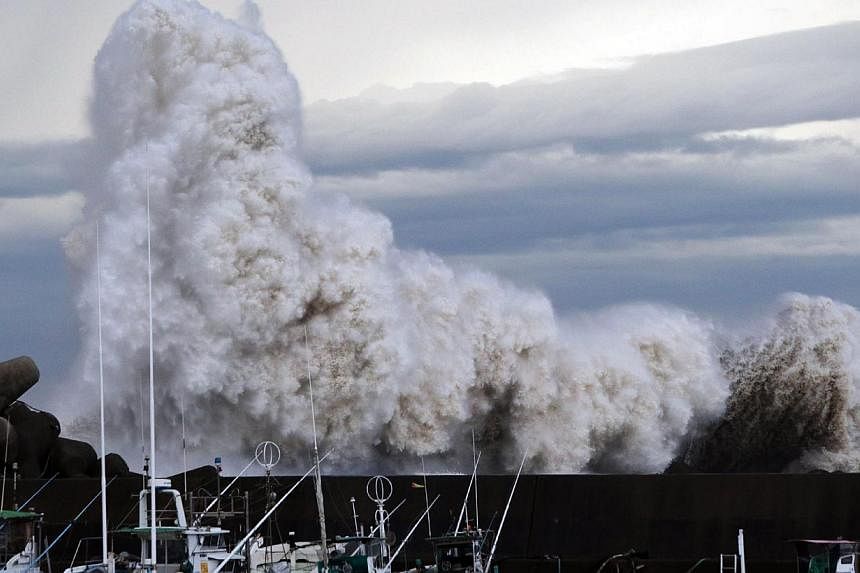Typhoon Phanfone slammed into Japan last weekend, killing seven, injuring more than 60 and leaving at least four missing.
The super typhoon also led to strong winds, heavy rain and poor visibility on the Japanese Grand Prix circuit in Suzuka, where French Formula One racer Jules Bianchi crashed after his vehicle aquaplaned.
Meanwhile, as Phanfone departs Japan, a stronger Typhoon Vongfong is headed for the southern tip of the country and is expected to make a landfall by the weekend.
We take a look at the difference between typhoons and hurricanes, and where they get their names from.
What are typhoons?
Typhoons are tropical storms or cyclones which form over the Pacific Ocean, to the north of the equator and west of the International Date Line.
Alternatively, they can also form on the eastern side of the Date Line and cross it.
Countries affected by typhoons include the Philippines, Japan and China.
Tropical cyclones in the northeast Pacific and northern Atlantic are called hurricanes, while those in the South Pacific and over the Indian Ocean are simply called cyclones.
Places that experience hurricanes include the United States, the Bahamas and Cuba.
Typhoons are classified according to the Saffir-Simpson Hurricane Wind Scale - a Category One typhoon has sustained wind speeds between 119 and 153 kmh, while a Category Five typhoon reaches speeds above 252 kmh.
Category 4 and 5 storms are also known as super typhoons.
Etymology
The word "typhoon" originated in the late 16th century, and derives partly from Greek (tuphon, or whirlwind), its Arabic form (tufan), as well as Cantonese (taai fung, or great wind). The current English spelling first appeared in poet Percy Bysshe Shelley's lyrical drama Prometheus Unbound, which was published in 1820.
How are typhoons named?
From 2000, the 14 nations and territories affected by typhoons, including China, the United States and Japan, submit names to the World Meteorological Organisation's Typhoon Committee.
The names are arranged into five lists, and typhoons are named by going down each list, which is cycled with each year.
Unlike tropical cyclones elsewhere, typhoons in the western Pacific are not named solely after people. Their titles can also refer to animals, flowers and astrological signs.
A typhoon can, however, have more than one name.
The Philippine Atmospheric, Geophysical and Astronomical Services Administration (Pagasa) has its own list for typhoons, consisting of human names. It currently has four sets of names that are used in rotation every four years, but names of typhoons that are particularly destructive are decommissioned.
Storms that cross from the eastern to western Pacific retain their original name, but their designation changes from hurricane to typhoon.
Recent typhoons: What do Haiyan, Phanfone and Vongfong mean?
1. Typhoon Haiyan (Nov 2013)
Typhoon Haiyan devastated portions of South-east Asia last November. This Category 5 typhoon killed more than 6,000 in the Philippines alone.
The name, contributed by China, means petrel (hai yan) - a type of seabird.
It was known as Typhoon Yolanda in the Philippines, due to Pagasa's alternative naming system.
Because of its extensive damage and high death toll, both names, Haiyan and Yolanda, will be retired.
2. Typhoon Phanfone (Sept/Oct 2014)
This Category 4 typhoon made a landfall over Japan on Oct 4, and has killed seven, injured at least 62 and left four missing so far. It has also affected the Caroline Islands and Mariana Islands.
On Oct 5, strong winds and heavy rainfall from Phanfone brought poor visibility onto the track of the 2014 Japanese Grand Prix in Suzuka. French Formula One driver Jules Bianchi was left with severe head injuries after he aquaplaned off the wet track and crashed into a recovery tractor.
The typhoon's name, contributed by the Lao People's Democratic Republic, is a Laotian term which means "animal". Its Filipino name is Neneng.
Phanfone was also the name of a typhoon in 2002 which affected areas including the Marshall Islands and Iwo Jima in Japan.
3. Typhoon Vongfong (Oct 2014)
Touted as the strongest typhoon this season, with sustained winds of more than 200kmh, this Category 5 typhoon has passed over Rota in the Marian Islands, Guam, and is believed to be headed straight for Japan.
Submitted by Macau, Vongfong means "wasp" in Cantonese, and was also used in the 2002 typhoon season. The storm is called Ompong in the Philippines.
Sources: usatoday30.usatoday.com, freedictionary.com, news.pia.gov.ph, ndtv.com, weather.com, guardianlv.com, theweathernetwork.com, nhc.noaa.gov


